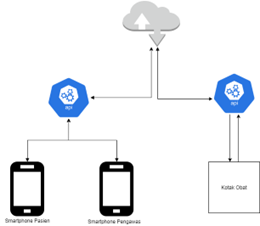Implementation of Internet of Things (IoT) in Smart Medicine Box for the Elderly
Implementasi Internet of Things (IOT) pada Kotak Obat Pintar untuk Lansia
DOI:
https://doi.org/10.21070/joincs.v6i1.1614Keywords:
Elderly, Internet of Things, Smartphone, Android Application, System Usability ScaleAbstract
Consuming medicine on time is important for people who are sick. Medicine that prescribed by a doctor or pharmacist have various kind of rules, for example some medicine must be taken 3 times a day, 2 times a day, and 1 time a day, then there are rules after eating or before eating. Patients treated in the hospital are supervised by nurses, doctors, and receive more supervision from the hospital, but what if the patient is outpatient and the patient is an elderly person. With the presence of IoT technology that is not too expensive, a smart medicine box was made to be used to remind outpatients to take medicine which implements IoT technology and the android application used to manage the pillbox. The medicine box can remind patients to take medicine with the alarm module that is in the smart medicine box. System Usability Scale (SUS) is used to measure the success of the application. Smart medicine box is tested directly with data created to test the existing system. The result of testing the smart medicine box with existing data show that for each existing case, the smart medicine box system runs as it should. Application test results from all respondents received an average score of SUS 73,75. The score results show that the application can be accepted, get a grade scale worth B, and get good grades.
References
[2] R. A. Sirait dan I. J. V. Lubis, “Pengaruh Kepatuhan Dan Motivasi Penderita TB Paru Terhadap TIngkat Kesembuhan Pengobatan Di Puskesmas Tanjung Morawa Kabupaten Deli Serdang Tahun 2017,” Jurnal Penelitian Kesmasy, vol. 1, no. 1, pp. 31-36, 2018.
[3] R. S. u. Daerah, “Aturan Tepat Minum Obat,” 11 April 2019. [Online]. Available: https://bulelengkab.go.id/detail/artikel/aturan-tepat-minum-obat-45.
[4] S. Madakam, R. Ramaswamy dan S. Tripathi, “Internet of Things (IoT): A Literature,” Journal of Computer and Communications,, vol. 3, pp. 164-173, 2015.
[5] J. Valdez dan J. Becker, “Understanding the I2C Bus,” Texas Instruments Incorporated, Dallas, 2015.
[6] C. A. Fauzi, “Medium,” 14 November 2018. [Online]. Available: https://medium.com/@cecepahmadfauzi93/rest-rest-api-dan-client-server-527a15e68ff2.
[7] D. H. S. Apt., Farmasetika Dasar dan Hitungan Farmasi, Jakarta: Penerbit Buku Kedokteran EGC, 2005, pp. 47-48..
[8] Husmiati, “Demensia Pada Lanjut Usia Dan Intervensi Sosial,” Solo Informa, vol. 2, no. 3, pp. 229-238, 2016.
[9] P. Elanthiraiyan dan D. S. Babu, “Smart Medicine and Physical Health System Using IoT,” IJCSMC, pp. 333-338, 2015.
[10] G. R. Talmale dan S. V. Vanjal, “Medicine Reminder and Monitoring System for Secure Health,” International Conference on Information Security & Privacy (ICISP2015),, pp. 471-476, 2015.
[11] K. Natarajan, B. Prasath dan P. Kokila, “Smart Health Care System Using Internet of Things,” Journal of Network Communications and Emerging Technologies (JNCET), vol. 6, no. 3, pp. 38-42, 3 March 2016.
[12] S. A. Ishak, H. Z. Abidin dan M. Muhammad, “Improving Medical Adherence using Smart Medicine Cabinet Monitoring System,” Indonesian Journal of Electrical Engineering and Computer Science, vol. 9, no. 1, pp. 164-169, 2018.
[13] D. V. da Silva, T. G. Concalves dan P. F. Pires, “Using IoT technologies to develop a low-cost smart medicine box,” Anais Estendidos do XXV Simpósio Brasileiro de Sistemas Multimídia e Web, pp. 97-101, 2019.
[14] J. Brooke, “SUS-A quick and dirty usability scale.,” dalam Usability evaluation in industry, London, Taylor & Francis , 1996, pp. 189-194.
[15] A. D. I. Puspitasari dan W. , “Sistem Pengendalian Suhu dan Kelembaban Kumbung Jamur,” Jurnal Fisika FLUX, vol. 1, no. 1, pp. 6-12, 2019.
[16] TEXAS INSTRUMENTS, “PCF8574,” 2 June 2020. [Online]. Available: https://www.ti.com/product/PCF8574. [16] Husmiati, “Demensia Pada Lanjut Usia dan Intervensi Sosial,” Sosio Informa, vol. 2, no. 3, pp. 229-238, 2016.
[17] D. Setiawan, “Hubungan Kepatuhan Minum Obat Terhadap Kualitas Hidup Pasien Hipertensi,” Jurnal Darul Azhar, pp. 15-18, 2019.
[18] F. Xia, L. T. Yang, L. Wang dan A. Vinel, “Internet of Things,” International Journal Of Communication Systems, pp. 1101-1102, 2012.
[19] Restyandito, E. Kurniawan dan T. M. Widagdo, “Mobile Application Menu Design for Elderly in Indonesia with Cognitive Consideration,” Journal of Physics: Conference Series, vol. 1196, p. 012058, 2019.
[20] Restyandito, J. A. Zebua dan K. A. Nugraha, “Perancangan Ikon pada Aplikasi Kesehatan untuk Lansia Berbasis Mobile,” 2019, vol. 6, no. 6, p. 637, Jurnal Teknologi Informasi dan Ilmu Komputer.






